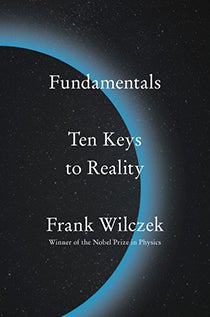Nobel laureate Frank Wilczek breaks down 10 key physics principles in new book 'Fundamentals'

Frank Wilczek, theoretical physicist, Nobel Prize laureate and professor of physics at Arizona State University.
Frank Wilczek, theoretical physicist, Nobel Prize laureate and professor of physics at Arizona State University, has spent much of his career exploring complex concepts in physics, researching the physical world and making influential scientific contributions.
In his latest book, “Fundamentals,” he offers readers, both experts in the field of physics and those casually interested in science, a glimpse into 10 essential concepts that form our understanding of what the world is and how it works.
“Friends, students and people who have attended my public lectures often asked me where they could learn what they would need to know in order to understand what’s going on at the frontiers of fundamental research in a genuine way, that gets beyond buzzwords,” Wilczek said. “I didn’t have a good answer, and after looking into it I came to the conclusion that there wasn’t one.”
He said his goal in writing “Fundamentals” was to create the answer to that kind of question. As the project evolved over the past four years, he came to realize that answering this question may involve philosophical or religious perspectives. This further inspired him to think about the questions of meaning and purpose that first interested him in the field of science.
Like many others, the COVID-19 pandemic forced Wilczek into isolation in mid-March. This break from his normal routines allowed him to take the time needed to finish “Fundamentals,” with most of the text that now appears in the book being written over an eight-week period last spring.
The 10 principles presented in the book cover everything from concepts relating to ideas that form our understanding of the universe like time, space, matter and energy to the history of fundamental science. In addition, Wilczek touches upon what could be on the horizon of scientific discovery. Wilczek’s favorite section, although he said it’s difficult to choose just one, is the third to last chapter titled "There’s Plenty More to See."

"Our best fundamental understanding of the physical world reveals that our senses leave a lot on the table,” he said. “We ordinarily perceive only a very small fraction of what’s there and what’s going on. An exciting possibility is to open the doors of perception wider, using modern technology, to give us superpowers. Our new SciHub initiative at ASU is taking steps in that direction.”
In addition to the release of his latest book, Wilczek said he is eager about two projects he has in the works at ASU: one with Professor Nathan Newman, focusing on converting axions into tangible signals, and another with Associate Professor Maulik Parikh and Postdoctoral Research Associate George Zaharaide looking at gravitational waves.
More Science and technology

Newly identified viruses found in dolphins
In a new study, researchers from Arizona State University together with national and international collaborators have identified…
ASU Interplanetary Lab celebrates 5 years of success
Five years ago, an Arizona State University student came up with the idea of creating a special satellite in what was then the…

ASU secures NSF grant to advance data science literacy as demand soars
In an era where data permeates every facet of our lives, the importance of data literacy cannot be overstated. Recognizing this…